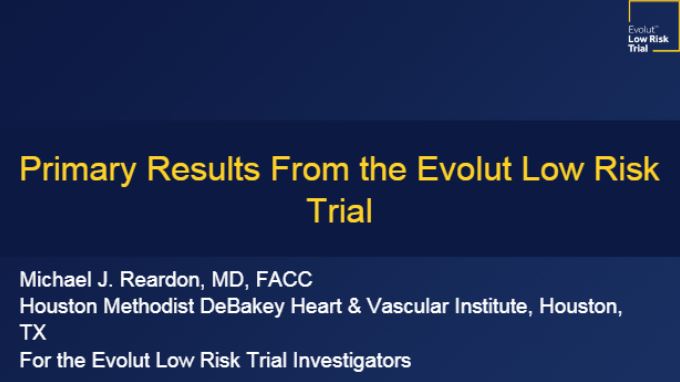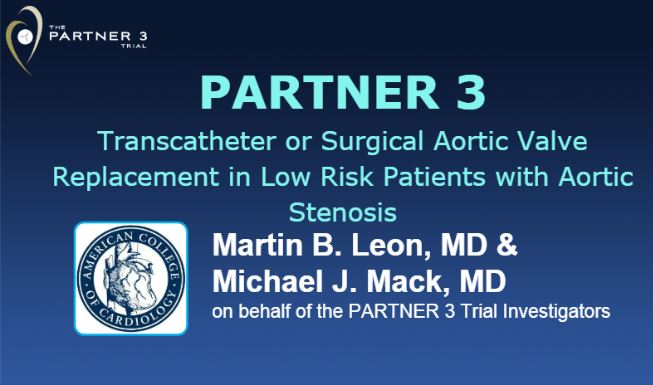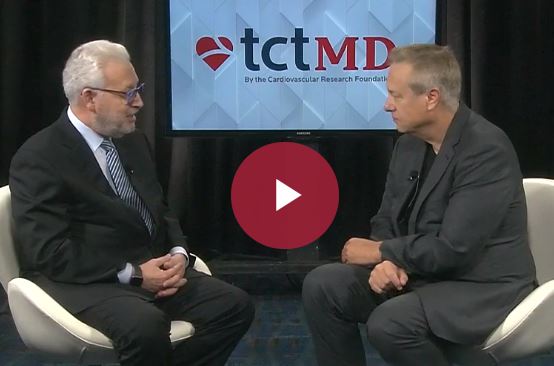FDA Expands TAVR Indication to Low-Risk Patients
Both Evolut R and Evolut PRO, as well Sapien 3, received the expanded indication in today’s eagerly awaited announcement.

(UPDATED) The US Food and Drug Administration has approved an expanded indication for the self-expanded Evolut series (Medtronic) and the balloon-expandable Sapien 3 and Sapien Ultra (Edwards Lifesciences) transcatheter heart valves for the treatment of patients with severe aortic stenosis at low risk for surgery.
The valves are now approved across the entire spectrum of risk, including patients ineligible for surgery, those at high or intermediate risk, and—as of today—those at low risk.

The expanded indication for the Medtronic devices is based on the results from the Evolut Low-Risk trial published earlier this year in the New England Journal of Medicine and presented at the American College of Cardiology (ACC) 2019 Scientific Sessions. In that study, investigators led by Michael Reardon, MD (Houston Methodist DeBakey Heart and Vascular Center, TX), randomized 1,468 patients to TAVR or to surgery. More than 96% of patients were treated with the Evolut R and Evolut PRO transcatheter heart valves. The primary incidence of death or disabling stroke at 24 months (the study’s primary endpoint) was 5.3% in the TAVR arm and 6.7% in the surgery group, a difference that met the statistical definition of noninferiority.
CoreValve, Evolut R, and Evolut PRO were approved for use in patients at intermediate risk for surgery in July 2017. CoreValve was approved in extremely high-risk and high-risk patients in 2014, with the newer Evolut R and Evolut PRO approved for use in these high-risk cohorts in 2015 and 2017, respectively.

The expanded indication for Sapien 3 and Sapien Ultra comes on the heels of PARTNER 3, also presented at the ACC meeting and published in NEJM. In that trial of 1,000 patients at low risk of mortality during cardiac surgery, TAVR was associated with a significantly lower risk of death from any cause, stroke, and rehospitalization when compared with patients treated with SAVR. The Sapien XT and Sapien 3 devices were approved in patients at intermediate risk for surgery in August 2016. The first-generation Sapien valve was approved in inoperable and high-risk patients in 2011 and 2012, respectively, with approval of the Sapien 3 device in high-risk/inoperable patients coming in 2015.
Demand for TAVR Among Educated ‘Consumers’
Both of the ACC presentations garnered national media attention in the lay press, with the results even discussed on the Dr. Oz show. Given this spotlight, Tamin Nazif, MD (Columbia University Irving Medical Center, New York, NY), said it’s not surprising that low-risk patients have had this option on their radar. He pointed out that despite the “win” for TAVR in PARTNER 3, and the comparable results compared with surgery in the Evolut Low-Risk Trial, surgery did very well and is still a very reasonable option for certain low-risk patients.
“I don’t think it’s true that we’re going to see 100% of patients undergoing TAVR once the approval comes,” he said. “It is true, though, that if we see 20 patients in a day, 19 of them are asking for TAVR.”
It is true, though, that if we see 20 patients in a day, 19 of them are asking for TAVR. Tamin Nazif
Indeed, speaking with TCTMD in the week leading up to today’s approval, Chandan Devireddy, MD (Emory University School of Medicine, Atlanta, GA), said their center had already been treating low-risk patients as part of the PARTNER 3 continued access registry. He noted that patients today are much more knowledgeable about TAVR devices, the procedure itself, and even the clinical trial results than they were 5 years ago.

“It’s amazing, we’ll get patients—and sometimes they’re half-joking and sometimes not—who come in and ask if they can get [TAVR] tomorrow,” he said. “We have to temper their enthusiasm with an explanation and education about the screening process and the need to review the clinical picture, so that we deliver a product and therapy that will truly be individualized for them and so that their outcomes are optimized.”
Several experts who spoke with TCTMD earlier this week offered the reminder that these approvals will not mean that a transcatheter approach is now suitable for all patients.
James McCabe, MD (University of Washington School of Medicine, Seattle), agreed there “is quite a bit of demand for TAVR in the low-risk patients, particularly among the educated consumers who have sought out our practice because we have this option.”
But both McCabe and Devireddy said they have already encountered low-risk patients unable to undergo TAVR because they don’t meet the inclusion/exclusion criteria of the PARTNER 3 trial.
“There are certainly folks who really have a goal in mind and that is often to stay away from surgical valve replacement,” McCabe said. “It’s been a bit of a hard conversation to have at the moment. We do have a few patients who are clearly low risk who screen failed [for the registry] and at least one of them has decided he’s not that symptomatic right now and he would like to wait. With him, we’re doing monthly check-ins to make sure everything is going OK.”
Ahead of today’s news, McCabe said it’s “hard to encourage somebody to wait when they have symptoms of aortic stenosis, particularly for a goal or a deadline we don’t know when it’s coming. But patients are making that choice.”

Devireddy said they have also had a few challenging conversations with low-risk patients who don’t meet the PARTNER 3 criteria, but who are set on TAVR. “Many come in with high hopes and expectations after reading about TAVR,” he said. “But I think it’s all about education to explain why we’re doing what we do. In the end, if the patient is truly symptomatic with severe aortic stenosis, the far majority of patients understand and want to get better.”
What Might the Future Hold?
Now that the devices have been approved for low-risk patients, there will be some important next steps, including the need for guidance around questions of about valve durability and the best options for younger patients. Steven Yakubov, MD (OhioHealth Heart and Vascular, Columbus OH), in particular, was curious how physicians will approach younger and younger patients.
“If the [Centers for Medicare & Medicaid Services] doesn’t provide us any guidance on age [in low-risk patients], what age will physicians be comfortable dipping down into?” said Yakubov. “Am I comfortable putting a TAVR into a 65-year-old or 60-year-old? What’s the 30-year strategy for a low-risk patient? The age that you’re willing to start at—that’s the big question for me.”
Prior to the FDA approval, Adnan Chhatriwalla, MD (Saint Luke’s MidAmerica Heart Institute, Kansas City, MO), had not been treating low-risk patients because his institution was not involved in either of the trials’ continued access registries, and instead had been directing these individuals toward surgery.
Like Yakubov, Chhatriwalla said there are still some important aspects of care to address. PARTNER 3 and the Evolut Low-Risk Trial included fairly elderly low-risk patients who didn’t have a significant amount of coronary artery disease. Additionally, patients with bicuspid valves were also excluded from the trials, as were patients with heavy calcium burden in the aortic annulus and left ventricular outflow tract, he said. “When we look at all these factors, there is a difference between a low-risk patient who is 78 years old and a patient who is 68 years old.”
Michael O’Riordan is the Managing Editor for TCTMD. He completed his undergraduate degrees at Queen’s University in Kingston, ON, and…
Read Full BioDisclosures
- Medtronic sponsored the Evolut TAVR Low-Risk Trial.
- Edwards Lifesciences sponsored the PARTNER 3 trial.
- Devireddy reports that his institution receives research funding from Medtronic and Edwards Lifesciences and that he serves on data safety monitoring boards for Medtronic.
- Nazif reports consulting fees/honoraria from Bayliss, BioTrace Medical, Boston Scientific, Edwards Lifesciences, and Medtronic.
- McCabe reports consulting for Abiomed, Boston Scientific, CSI, Edwards Lifesciences, Teleflex, and receiving grant support from Abiomed.


anant singh